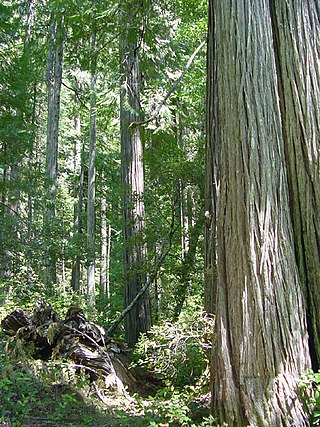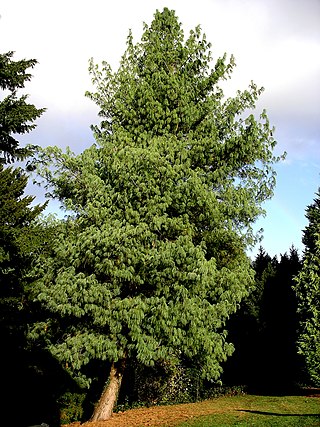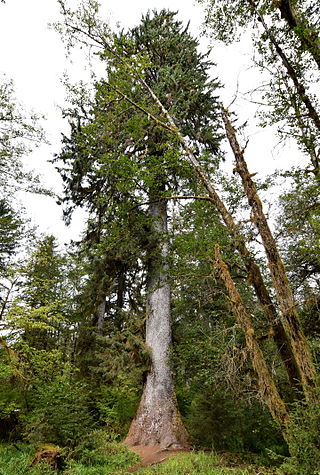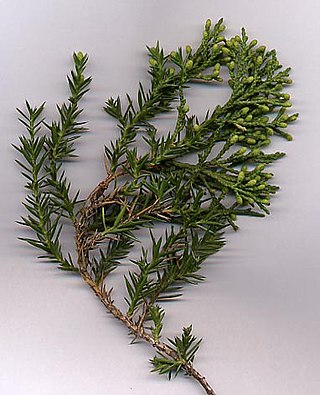
A cherry is the fruit of many plants of the genus Prunus, and is a fleshy drupe.

A spruce is a tree of the genus Picea, a genus of about 40 species of coniferous evergreen trees in the family Pinaceae, found in the northern temperate and boreal (taiga) regions of the Earth. Picea is the sole genus in the subfamily Piceoideae. Spruces are large trees, from about 20 to 60 m tall when mature, and have whorled branches and conical form.

Picea mariana, the black spruce, is a North American species of spruce tree in the pine family. It is widespread across Canada, found in all 10 provinces and all 3 territories. It is the official tree of the province of Newfoundland and Labrador and is that province's most numerous tree. The range of the black spruce extends into northern parts of the United States: in Alaska, the Great Lakes region, and the upper Northeast. It is a frequent part of the biome known as taiga or boreal forest.

Pinus nigra, the Austrian pine or black pine, is a moderately variable species of pine, occurring across Southern Europe from the Iberian Peninsula to the eastern Mediterranean, on the Anatolian peninsula of Turkey, Corsica and Cyprus, as well as Crimea and in the high mountains of Northwest Africa.

Chamaecyparis lawsoniana, known as Port Orford cedar or Lawson cypress, is a species of conifer in the genus Chamaecyparis, family Cupressaceae. It is native to Oregon and northwestern California, and grows from sea level up to 4,900 feet (1,500 m) in the valleys of the Klamath Mountains, often along streams.

Picea abies, the Norway spruce or European spruce, is a species of spruce native to Northern, Central and Eastern Europe.

Pinus wallichiana is a coniferous evergreen tree native to the Himalaya, Karakoram and Hindu Kush mountains, from eastern Afghanistan east across northern Pakistan and north west India to Yunnan in southwest China. It grows in mountain valleys at altitudes of 1800–4300 m, reaching 30–50 m (98–164 ft) in height. It favours a temperate climate with dry winters and wet summers. In Pashto, it is known as Nishtar.

Pinus muricata, the bishop pine, is a pine with a very restricted range: mostly in California, including several offshore Channel Islands, and a few locations in Baja California, Mexico. It is always on or near the coast.

Picea sitchensis, the Sitka spruce, is a large, coniferous, evergreen tree growing to almost 100 meters (330 ft) tall, with a trunk diameter at breast height that can exceed 5 m (16 ft). It is by far the largest species of spruce and the fifth-largest conifer in the world, and the third-tallest conifer species. The Sitka spruce is one of the few species documented to exceed 90 m (300 ft) in height. Its name is derived from the community of Sitka in southeast Alaska, where it is prevalent. Its range hugs the western coast of Canada and the US, continuing south into northernmost California.

Abies nordmanniana, the Nordmann fir or Caucasian fir, is a fir indigenous to the mountains south and east of the Black Sea, in Turkey, Georgia and the Russian Caucasus. It occurs at altitudes of 900–2,200 m on mountains with precipitation of over 1,000 mm.

Juniperus chinensis, the Chinese juniper is a species of plant in the cypress family Cupressaceae, native to China, Myanmar, Japan, Korea and the Russian Far East. Growing 1–20 metres tall, it is a very variable coniferous evergreen tree or shrub.

Cedrus deodara, the deodar cedar, Himalayan cedar, or deodar, is a species of cedar native to the Himalayas.

Picea breweriana, known as Brewer spruce, Brewer's weeping spruce, or weeping spruce, is a species of spruce native to western North America, where it is one of the rarest on the continent. The specific epithet breweriana is in honor of the American botanist William Henry Brewer.

The blue spruce, also commonly known as green spruce, Colorado spruce, or Colorado blue spruce, is a species of spruce tree native to North America in Arizona, Colorado, Idaho, New Mexico, Utah and Wyoming. It is noted for its blue-green colored needles, and has therefore been used as an ornamental tree in many places far beyond its native range.

Picea jezoensis, the dark-bark spruce, Ezo spruce, Yezo spruce, or Jezo spruce, is a large evergreen tree growing to 30–50 m tall and with a trunk diameter of up to 2 m. It is native to northeast Asia, from the mountains of central Japan and the Changbai Mountains on the China-North Korea border, north to eastern Siberia, including the Sikhote-Alin, Kuril Islands, Sakhalin and Kamchatka. It is found in cold but humid temperate rain forests, and nowhere does its range extend more than 400 km from the Pacific Ocean. The specific epithet jezoensis derives from Ezo, an old name for Hokkaido and other islands north of the Japanese island of Honshu, where the species is found.

Picea orientalis, commonly known as the Oriental spruce or Caucasian spruce, is a species of spruce native to the Caucasus and adjacent northeast Turkey.

Ilex aquifolium, the holly, common holly, English holly, European holly, or occasionally Christmas holly, is a species of flowering plant in the family Aquifoliaceae, native to western and southern Europe, northwest Africa, and southwest Asia. It is regarded as the type species of the genus Ilex, which by association is also called "holly". It is an evergreen tree or shrub found, for example, in shady areas of forests of oak and in beech hedges. In the British Isles it is one of very few native hardwood evergreen trees. It has a great capacity to adapt to different conditions and is a pioneer species that repopulates the margins of forests or clearcuts.

Larix kaempferi, the Japanese larch or karamatsu in Japanese, is a species of larch native to Japan, in the mountains of Chūbu and Kantō regions in central Honshū.

Picea smithiana is a species of evergreen tree in the family Pinaceae family. It is referred to by the common names morinda spruce and West Himalayan spruce, and is a spruce native to the western Himalaya and adjacent mountains, from northeast Afghanistan, northern Pakistan, India to central Nepal. It grows at altitudes of 2,400-3,600 m in forests together with deodar cedar, blue pine and pindrow fir.

Acer palmatum, commonly known as Japanese maple, palmate maple, or smooth Japanese maple (Korean: danpungnamu, 단풍나무, Japanese: irohamomiji, イロハモミジ, or momiji,, is a species of woody plant native to Korea, Japan, China, eastern Mongolia, and southeast Russia. Many different cultivars of this maple have been selected and they are grown worldwide for their large variety of attractive forms, leaf shapes, and spectacular colors.


























